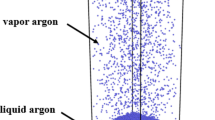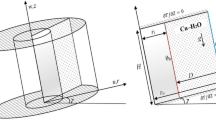Abstract
Evaporation in microstructures has been proven to be a heat transfer enhancement compared with evaporation on flat surfaces due to the thin films formed in the porous or grooved surfaces. To investigate the evaporation characteristics in sintered porous wicks for cryogenic loop heat pipes, a more realistic geometric model to characterize the porous skeleton is developed. Then, a mathematical model considering the Marangoni effect and slip velocity effect to predict the liquid–vapor interface is built. The evaporation interface can be divided into the thin-film region and intrinsic meniscus region. A new solution method calculating from the intersection of these two regions is established and validated, and the initial boundary conditions are not dependent on the contact angle whose value is small and ambiguous for cryogenic fluids. Then the evaporation characteristics of the thin-film region are discussed. About 40% of the temperature drop occurs in the thin-film region, and the evaporation thermal resistance should be considered in this region. Finally, the parametric analysis is conducted to study the effects of superheat, pressure difference at the interface, accommodation coefficient and pore radius on the interface profile and evaporation heat transfer process in sintered microporous structures. The liquid–vapor interface recedes with the superheat increasing and the mean heat transfer coefficient of the interface decreases. With the increase of the pressure difference at the interface, the liquid–vapor interface recedes and the mean heat transfer coefficient decreases. The mean heat transfer coefficient increases with the accommodation coefficient despite the coverage of the liquid–vapor interface reducing and small pores would be helpful to enhance heat transfer in porous media.




















Similar content being viewed by others
Abbreviations
- A:
-
Dispersion constant (J)
- hfg:
-
Latent heat (J/kg)
- K:
-
Curvature (m-1)
- \(\overline{M }\) :
-
Molecular weight (kg/mol)
- pc:
-
Capillary pressure (Pa)
- pd:
-
Disjoining pressure (Pa)
- q:
-
Heat transfer rate (W)
- \(\overline{R }\) :
-
Universal gas constant (J/mol·K)
- r:
-
Polar radius coordinate (m)
- T:
-
Temperature (K)
- u:
-
Velocity (m/s)
- x:
-
X-coordinate (m)
- y:
-
Y-coordinate (m)
- β:
-
Slip coefficient (m)
- δ:
-
Thickness (m)
- ρ:
-
Density (kg/m3)
- θ:
-
Angular coordinate (-)
- μ:
-
Dynamic viscosity (N·s/m2)
- σ:
-
Surface tension (N/m)
- \(\widehat{\sigma }\) :
-
Accommodation coefficient (-)
- λ:
-
Thermal conductivity (W/m·K)
- c:
-
Conduction
- e:
-
Evaporation
- l:
-
Liquid
- lv:
-
Liquid-vapor interface
- sat:
-
Saturation
- v:
-
Vapor
- w:
-
Wall.
References
Accorinti, F., Ayel, V., Bertin, Y.: Steady-state analysis of a Capillary Pumped Loop for Terrestrial Application with methanol and ethanol as working fluids. Int. J. Therm. Sci. 137, 571–583 (2019). https://doi.org/10.1016/j.ijthermalsci.2018.10.036
Adera, S., Antao, D., Raj, R., Wang, E.N.: Design of micropillar wicks for thin-film evaporation. Int. J. Heat Mass Transf. 101, 280–294 (2016). https://doi.org/10.1016/j.ijheatmasstransfer.2016.04.107
Akkus, Y., Dursunkaya, Z.: A new approach to thin film evaporation modeling. Int. J. Heat Mass Transf. 101, 742–748 (2016). https://doi.org/10.1016/j.ijheatmasstransfer.2016.05.091
Akkus, Y., Tarman, H.I., Cetin, B., Dursunkaya, Z.: Two-dimensional computational modeling of thin film evaporation. Int. J. Therm. Sci. 121, 237–248 (2017). https://doi.org/10.1016/j.ijthermalsci.2017.07.013
Bai, L., Lin, G., Wen, D.: Parametric analysis of steady-state operation of a CLHP. Appl. Therm. Eng. 30, 850–858 (2010). https://doi.org/10.1016/j.applthermaleng.2009.12.014
Carey, V.P.: Liquid-Vapor Phase-Change Phenomena. Hemisphere, New York (1992)
Demsky, S.M., Ma, H.B.: Thin film evaporation on a curved surface. Microscale Thermophys. Eng. 8, 285–299 (2004). https://doi.org/10.1080/10893950490477590
Do, K.H., Kim, S.J., Garimella, S.V.: A mathematical model for analyzing the thermal characteristics of a flat micro heat pipe with a grooved wick. Int. J. Heat Mass Transf. 51, 4637–4650 (2008). https://doi.org/10.1016/j.ijheatmasstransfer.2008.02.039
Du, S.Y., Zhao, Y.H.: New boundary conditions for the evaporating thin-film model in a rectangular micro channel. Int. J. Heat Mass Transf. 54, 3694–3701 (2011). https://doi.org/10.1016/j.ijheatmasstransfer.2011.02.059
Gatapova, E.Y., Kabov, O.A.: Slip effect on shear-driven evaporating liquid film in microchannel. Microgravity Sci. Technol. 19, 132–134 (2007). https://doi.org/10.1007/BF02915775
Hallinan, K.P., Chebaro, H.C., Kim, S.J., Chang, W.S.: Evaporation from an extended meniscus for nonisothermal interfacial conditions. J. Thermophys. Heat Transfer 8, 709–716 (1994). https://doi.org/10.2514/3.602
Hanchak, M.S., Vangsness, M.D., Byrd, L.W., Ervin, J.S.: Thin film evaporation of n-octane on silicon: Experiments and theory. Int. J. Heat Mass Transf. 75, 196–206 (2014). https://doi.org/10.1016/j.ijheatmasstransfer.2014.03.063
Hu, H., Weibel, J.A., Garimella, S.V.: Role of nanoscale roughness in the heat transfer characteristics of thin film evaporation. Int. J. Heat Mass Transf. 150, 119306 (2020). https://doi.org/10.1016/j.ijheatmasstransfer.2020.119306
Jiao, A.J., Ma, H.B., Critser, J.K.: Heat Transport Characteristics in a Miniature Flat Heat Pipe With Wire Core Wicks. J. Heat Transfer 130, 261–272 (2008). https://doi.org/10.1115/1.2887858
Lemmon, E.W., Huber, M.L., Mclinden, M.O.: NIST Standard ReferenceDatabase 23: Reference Fluid Thermodynamic and Transport Properties-REFPROP. 9.0. NIST NSRDS. (2010)
Li, Y., Li, Z., Zhou, W., Zeng, Z., Yan, Y., Li, B.: Experimental investigation of vapor chambers with different wick structures at various parameters. Exp. Thermal Fluid Sci. 77, 132–143 (2016). https://doi.org/10.1016/j.expthermflusci.2016.04.017
Lips, S., Sartre, V., Lefevre, F., Khandekar, S., Bonjour, J.: Overview of heat pipe studies during the period 2010–2015. Interfacial Phenomena and Heat Transfer. 4, 33–53 (2016). https://doi.org/10.1615/InterfacPhenomHeatTransfer.2016016345
Ma, H.B., Cheng, P., Borgmeyer, B., Wang, Y.X.: Fluid flow and heat transfer in the evaporating thin film region. Microfluidics Nanofluidics. 4, 237–243 (2008). https://doi.org/10.1007/s10404-007-0172-5
Mehrizi, A.A., Wang, H.: Evaporation-induced receding contact lines in partial-wetting regime on a heated substrate. Int. J. Heat Mass Transf. 124, 279–287 (2018). https://doi.org/10.1016/j.ijheatmasstransfer.2018.03.066
Nishikawara, M., Ueda, Y., Yanada, H.: Static and Dynamic Liquid-Vapor Phase Distribution in the Capillary Evaporator of a Loop Heat Pipe. Microgravity Sci. Technol. 31, 61–71 (2019). https://doi.org/10.1007/s12217-018-9668-8
Panchamgam, S.S., Chatterjee, A., Plawsky, J.L., Wayner, P.C.: Comprehensive experimental and theoretical study of fluid flow and heat transfer in a microscopic evaporating meniscus in a miniature heat exchanger. Int. J. Heat Mass Transf. 51, 5368–5379 (2008). https://doi.org/10.1016/j.ijheatmasstransfer.2008.03.023
Panchamgam, S.S., Plawsky, J.L., Wayner, P.C.: Experimental Evaluation of Marangoni Shear in the Contact Line Region of an Evaporating 99+% Pure Octane Meniscus. J. Heat Transfer 129, 1059–1066 (2007). https://doi.org/10.1115/1.2759970
Park, K., Noh, K.J., Lee, K.S.: Transport phenomena in the thin-film region of a micro-channel. Int. J. Heat Mass Transf. 46, 2381–2388 (2003). https://doi.org/10.1016/S0017-9310(02)00541-0
Plawsky, J.L., Ojha, M., Chatterjee, A., Wayner, P.C.: Review of the effects of surface topography, surface chemistry, and fluid physics on evaporation at the contact line. Chem. Eng. Commun. 196, 658–696 (2008). https://doi.org/10.1080/00986440802569679
Qu, W., Ma, T.: Effects of the polarity of working fluids on vapor-liquid flow and heat transfer characteristics in a capillary. Microscale Thermophys. Eng. 6, 175–190 (2002). https://doi.org/10.1080/10893950290053803
Qu, W., Ma, T., Miao, J., Wang, J.: Effects of radius and heat transfer on the profile of evaporating thin liquid film and meniscus in capillary tubes. Int. J. Heat Mass Transf. 45, 1879–1887 (2002). https://doi.org/10.1016/S0017-9310(01)00296-4
Setchi, A., Chen, Y., Yu, J., Wang, H.: Structural effects in partially-wetting thin evaporating liquid films near the contact line. Int. J. Heat Mass Transf. 132, 420–430 (2019). https://doi.org/10.1016/j.ijheatmasstransfer.2018.11.151
Soma, S., Kunugi, T.: Water evaporation in parallel plates. Int. J. Heat Mass Transf. 110, 778–782 (2017). https://doi.org/10.1016/j.ijheatmasstransfer.2017.03.085
Stephan, P.C., Busse, C.A.: Analysis of the heat transfer coefficient of grooved heat pipe evaporator walls. Int. J. Heat Mass Transf. 35, 383–391 (1992). https://doi.org/10.1016/0017-9310(92)90276-X
Truong, J.G., Wayner, P.C.: Effects of capillary and van der Waals dispersion forces on the equilibrium profile of a wetting liquid: Theory and experiment. J. Chem. Phys. 87, 4180–4188 (1987). https://doi.org/10.1063/1.452922
Tsai, Y.Y., Lee, C.H.: Experimental study of evaporative heat transfer in sintered powder structures at low superheat levels. Exp. Thermal Fluid Sci. 52, 230–238 (2014). https://doi.org/10.1016/j.expthermflusci.2013.09.016
Wang, H., Garimella, S.V., Murthy, J.Y.: Characteristics of an evaporating thin film in a microchannel. Int. J. Heat Mass Transf. 50, 3933–3942 (2007).https://doi.org/10.1016/j.ijheatmasstransfer.2007.01.052
Wang, R., Jakhar, K., Antao, D.S.: Unified Modeling Framework for Thin-Film Evaporation from Micropillar Arrays Capturing Local Interfacial Effects. Langmuir 35, 12927–12935 (2019). https://doi.org/10.1021/acs.langmuir.9b02048
Wayner, P.C., Kao, Y.K., Lacroix, L.V.: The interline heat-transfer coefficient of an evaporating wetting film. Int. J. Heat Mass Transf. 19, 487–492 (1976).https://doi.org/10.1016/0017-9310(76)90161-7
Wee, S.K., Kihm, K.D., Hallinan, K.P.: Effects of the liquid polarity and the wall slip on the heat and mass transport characteristics of the micro-scale evaporating transition film. Int. J. Heat Mass Transf. 48, 265–278 (2005). https://doi.org/10.1016/j.ijheatmasstransfer.2004.08.021
Wong, S.C., Liou, J.H., Chang, C.W.: Evaporation resistance measurement with visualization for sintered copper-powder evaporator in operating flat-plate heat pipes. Int. J. Heat Mass Transf. 53, 3792–3798 (2010). https://doi.org/10.1016/j.ijheatmasstransfer.2010.04.031
Zhao, Y., Wang, N., Yan, T., Liang, J., Chen, H.: Experimental study on operating characteristics of a cryogenic loop heat pipe without additional power consumption. Appl. Therm. Eng. 184, 116262 (2020). https://doi.org/10.1016/j.applthermaleng.2020.116262
Acknowledgements
This work was supported by the National Basic Research Program of China (973 program) under contract No. 613322.
Author information
Authors and Affiliations
Corresponding author
Ethics declarations
Conflict of Interests
The authors declare that they have no known competing financial interests or personal relationships that could have appeared to influence the work reported in this paper.
Additional information
Publisher's Note
Springer Nature remains neutral with regard to jurisdictional claims in published maps and institutional affiliations.
Appendix A
Appendix A
The liquid velocity profile can be written as,
Then, the first derivative of the liquid velocity can be expressed as,
The boundary conditions are as follows.
Substitute Eqs. (33) and (34) into Eq. (35),
According to the second equation in Eq. (36), C1 can be written as,
Then, take the expression of C1 into the first equation in Eq. (36), and C2 can be solved:
Rights and permissions
About this article
Cite this article
Chen, X., Qi, C., Wang, W. et al. Theoretical Analysis of Cryogenic Fluid Evaporation in Sintered Microporous Structures. Microgravity Sci. Technol. 34, 14 (2022). https://doi.org/10.1007/s12217-022-09932-9
Received:
Accepted:
Published:
DOI: https://doi.org/10.1007/s12217-022-09932-9




